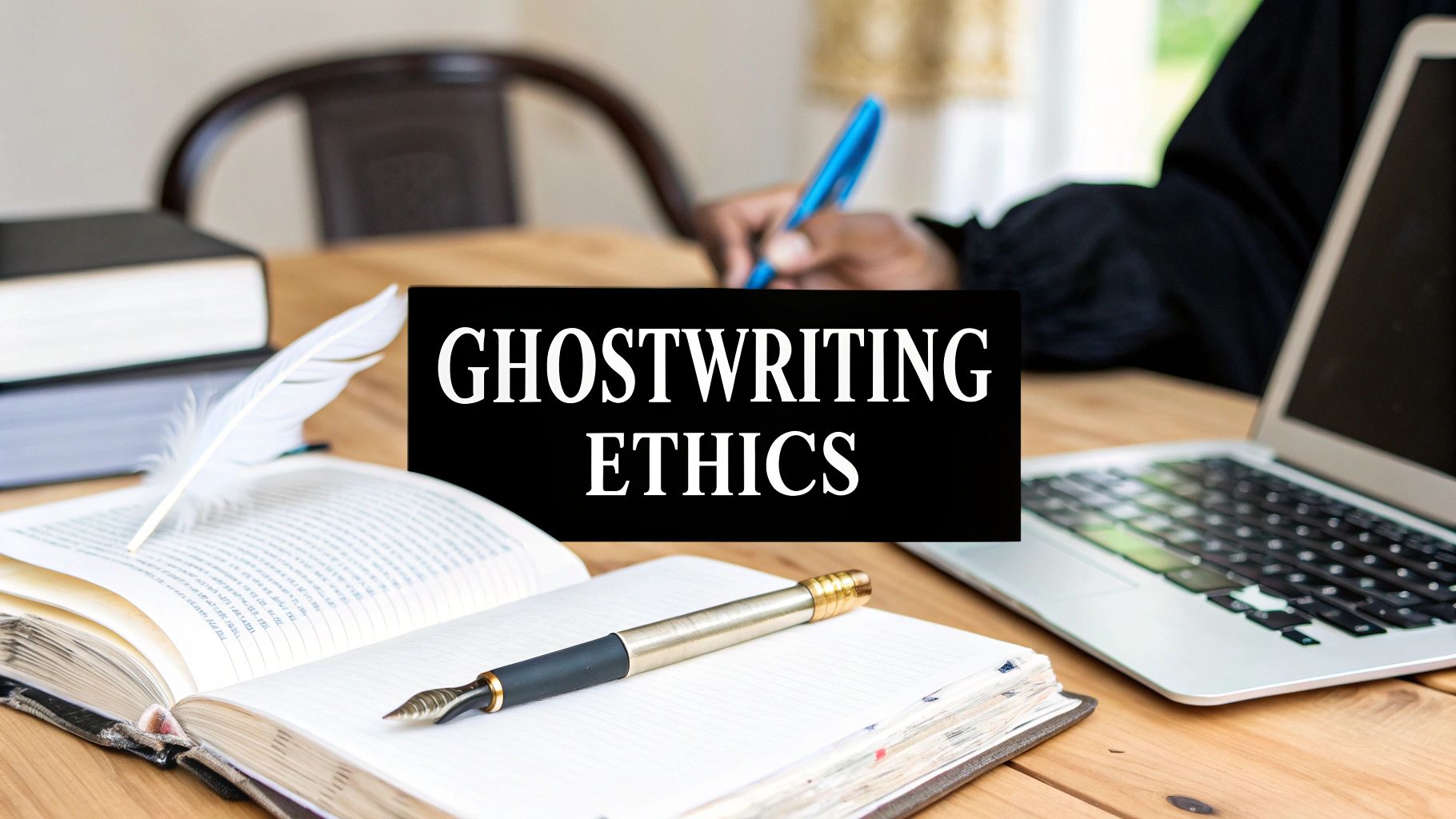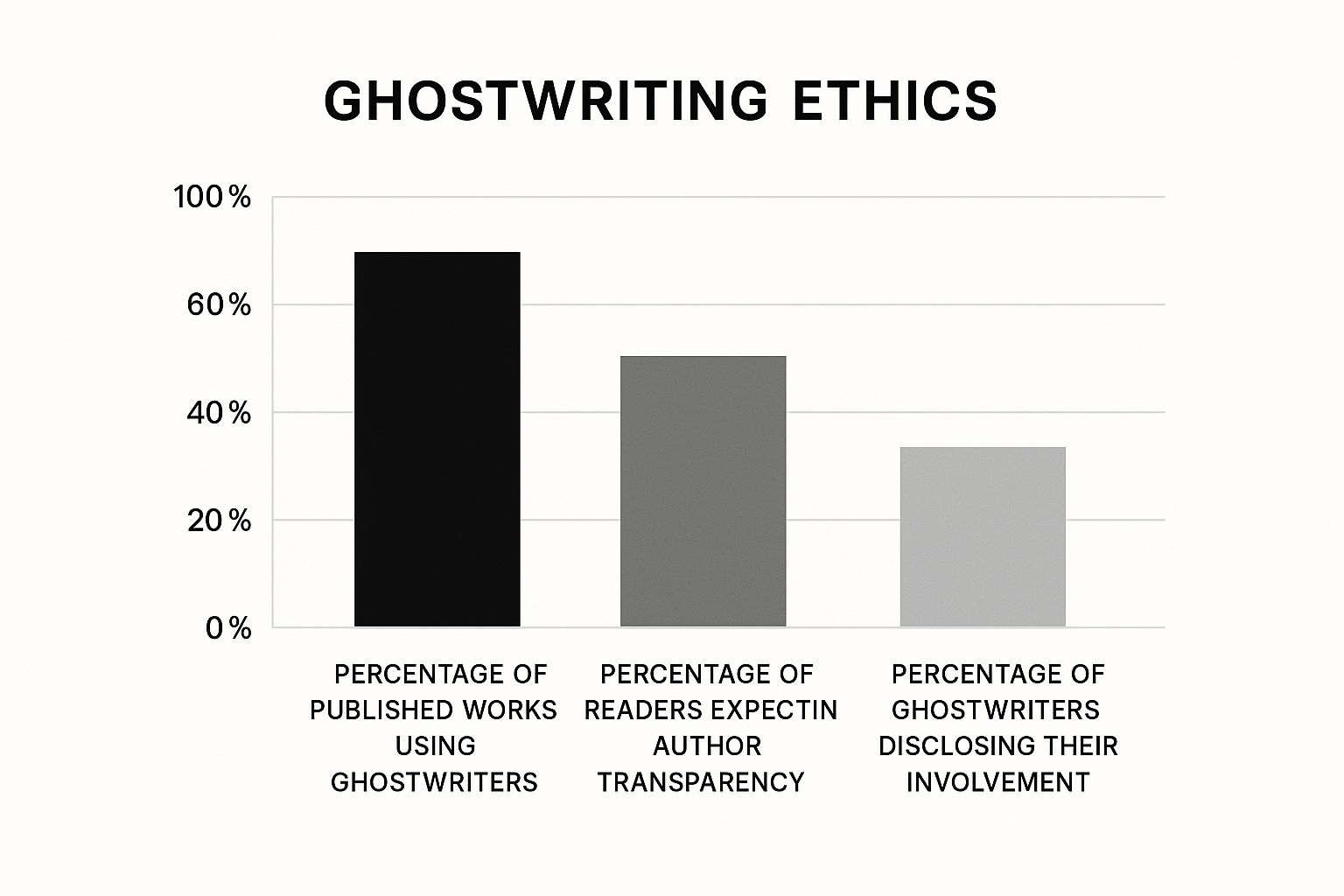
Ghostwriting Ethics: Essential Guidelines for Integrity
Published on 2025-04-30
The Ethical Landscape of Modern Ghostwriting
Ghostwriting exists in a complex ethical space. It involves balancing the writer's creative contribution with the named author's public attribution. This raises questions about authenticity, transparency, and integrity.
Navigating the Nuances of Attribution
Attribution is a central ethical dilemma in ghostwriting. How much credit should the ghostwriter receive? How much disclosure is necessary? The context matters significantly. Ghostwriting a celebrity memoir has different implications than a CEO's thought leadership article or a medical journal article.
Contractual non-disclosure clauses often complicate matters. These prevent ghostwriters from publicly acknowledging their work. Such clauses protect the client’s image, but they also obscure the ghostwriter's role, raising concerns about intellectual property and fair compensation.
Balancing Client Needs and Authenticity
Ghostwriters must balance client expectations with authenticity. Clients hire ghostwriters to express their ideas, but the writer's style inevitably shapes the final product. This can result in work that doesn't fully represent the client's voice, potentially misleading the audience. Ethical standards and disclosure practices vary across industries, from books and journalism to marketing and academia.
This concern is amplified in academic and medical fields. Ghostwriting in scientific literature has a documented prevalence between 0.9% and 75%, depending on the field. Pharmaceutical articles show particularly high rates. A 2010 New York Times review of journals like JAMA and The Lancet found ghostwriting in 4.6%-10.9% of articles. Explore this topic further. This practice often involves pharmaceutical companies commissioning writers without attribution, creating undisclosed conflicts of interest.
The Ghostwriting Spectrum: An Industry Breakdown
The following data chart displays ghostwriting prevalence and disclosure practices across several industries:

The data chart shows academic/medical ghostwriting with high prevalence and low disclosure, raising serious ethical flags. Celebrity memoir ghostwriting, while potentially prevalent, often includes some acknowledgment (like "as told to"). The business/marketing sector falls between these extremes, with varying disclosure practices. This visualization emphasizes the need for more transparency and stronger ethical guidelines in the ghostwriting field.
To further understand the ethical implications, let's examine the prevalence of ghostwriting across various sectors. The table below, "Ghostwriting Prevalence by Industry," provides a comparison of documented ghostwriting rates, typical disclosure practices, and the primary ethical concerns in different fields and contexts.
| Industry/Field | Estimated Prevalence | Typical Disclosure Practices | Primary Ethical Concerns |
|---|---|---|---|
| Academic/Medical Publishing | 0.9% - 75% (highly variable) | Often undisclosed; sometimes acknowledged as "statistical assistance" | Conflicts of interest, lack of transparency, potential for bias |
| Pharmaceutical Research | High (exact figures difficult to obtain due to non-disclosure) | Rarely disclosed | Similar to academic/medical publishing, with heightened concerns due to financial incentives |
| Book Publishing (Memoirs/Biographies) | Moderate to High | Often acknowledged as "with" or "as told to" | Issues of authorship and authenticity, potential for misrepresentation |
| Business/Marketing (Thought Leadership, Corporate Communications) | Moderate | Variable; sometimes disclosed, often not | Transparency, potential for misleading audiences about expertise |
| Journalism | Low to Moderate | Generally discouraged and rarely disclosed, except in specific circumstances (e.g., collaborative investigative reporting) | Credibility and accuracy, potential for plagiarism |
This table highlights the wide range of ghostwriting practices and ethical concerns across different industries. It emphasizes the need for context-specific guidelines and increased transparency to ensure ethical conduct in ghostwriting. The future of ethical ghostwriting relies on open discussions about these complexities, promoting awareness of the responsibilities and challenges for both ghostwriters and their clients.
Confronting the Medical Ghostwriting Crisis
The ethical implications of ghostwriting are particularly concerning in medical and academic fields. Undisclosed authorship can have significant consequences, potentially impacting human lives and eroding public trust in science. The integrity of research is paramount, and ghostwriting practices raise serious questions about its validity and reliability.
Unveiling the Influence of Pharmaceuticals
Pharmaceutical companies often play a significant role in medical ghostwriting. They may commission writers to create articles that portray their products favorably, without disclosing their involvement. This can lead to biased research, where trial results are manipulated and negative findings are omitted. Such practices can ultimately shape medical practice based on skewed information.
For instance, a study might downplay a new drug's side effects or exaggerate its effectiveness. This can influence doctors' prescribing habits, potentially harming patients. Furthermore, this undermines the credibility of scientific research, eroding the public's trust in medical advancements and health initiatives.
The Erosion of Scientific Credibility
The ramifications of medical ghostwriting extend far beyond individual patients. Compromised research undermines the entire scientific process. This can lead to the adoption of flawed medical practices based on inaccurate information. It also fosters distrust, making it difficult for the public to discern reliable scientific findings from commercially driven narratives. This ultimately affects public health policy and the progression of medical knowledge.
The lack of consistent policies against ghostwriting exacerbates this problem. As of 2014, only 13 of the top 50 U.S. medical journals had clear anti-ghostwriting guidelines. Read the full research here. Institutions are often slow to act due to financial ties with pharmaceutical companies, sometimes avoiding confronting influential researchers who bring in industry funding. Journals like PLoS Medicine have advocated for retracting ghostwritten articles and notifying institutions of misconduct, highlighting the tension between financial incentives and ethical obligations in medical publishing.

Structural Forces at Play
Several contributing factors fuel the medical ghostwriting crisis:
- Publication Pressures: Researchers face intense pressure to publish frequently, making them vulnerable to ghostwriting offers.
- Financial Incentives: Pharmaceutical companies offer substantial financial rewards to researchers and institutions, creating conflicts of interest and compromising oversight.
- Lack of Transparency: The opaque nature of ghostwriting makes it challenging to identify and address effectively.
These structural forces create an environment ripe for ethical breaches. The pressure to publish, coupled with financial inducements, can lead researchers to prioritize career advancement and funding over research integrity.
Addressing the Crisis: A Call for Change
Combating the medical ghostwriting crisis requires a multifaceted approach. Journals need stricter guidelines and robust enforcement mechanisms. Institutions must prioritize research integrity over financial gains. Researchers need education about the ethical implications of ghostwriting and empowerment to resist these pressures.
Collective action is crucial to ensure medical research remains objective, credible, and serves patients' best interests. This includes supporting organizations like the European Medical Writers Association (EMWA), which promotes transparent authorship. Their guidelines emphasize credited contributions and full disclosure of any writing assistance. Wider adoption of such guidelines is essential to restoring trust and integrity in medical publications.
Building Your Ethical Ghostwriting Framework
Shifting from theoretical discussions to practical application, this section offers tangible guidelines for ghostwriters committed to ethical practices. Building a successful career while upholding strong moral principles is entirely possible. We'll construct a robust ethical framework through actionable steps, balancing client needs with professional standards.
Contracts: The Foundation of Ethical Collaboration
Contracts are crucial for establishing clear expectations and protecting both the ghostwriter and the client. A well-drafted contract serves as a roadmap for the project, outlining responsibilities and ensuring everyone is on the same page. This includes defining the scope of work, payment terms, and intellectual property rights.
For example, the contract should specify who owns the copyright to the finished work and what rights the client has to use it. Additionally, it should address potential disputes and provide a mechanism for resolving them.
Communicating Ethical Boundaries: Transparency and Trust
Open communication with clients is essential for navigating ethical complexities. Ghostwriters should clearly communicate their ethical boundaries from the outset. This creates a foundation of transparency and trust.
For instance, if a ghostwriter isn't comfortable with certain topics or writing styles, they should discuss this with the client upfront. Furthermore, it’s vital to address confidentiality expectations. How will client information be handled? How will the ghostwriting relationship itself be disclosed (or not disclosed)?
Honest dialogue about these considerations prevents misunderstandings and fosters a productive working relationship.
Project Alignment: Choosing Assignments That Reflect Your Values
Not every project will align with a ghostwriter's values. Developing clear criteria for selecting projects is a key component of ethical practice. This involves considering the subject matter, the client's intentions, and the potential impact of the work.
For instance, a ghostwriter might decline a project that promotes harmful products or perpetuates misinformation. However, ethical lines can be blurry. Ethical ghostwriting in non-academic fields often prioritizes transparency. Celebrity memoirs, for example, commonly use "with" credits. Learn more about ghostwriting ethics here: https://selfpublishingadvice.org/ghostwriting-ethics/. Ultimately, choosing projects that resonate with your values ensures ethical and professional fulfillment.

Navigating Difficult Client Requests: Maintaining Professionalism
Even with clear contracts and open communication, challenging situations may arise. Clients might make requests that push ethical boundaries. Developing strategies for addressing these situations is critical. This might involve revisiting the contract, renegotiating terms, or even declining the request altogether.
Declining a project doesn't have to damage the client relationship. Explain your reasoning clearly and professionally, offering alternative solutions if possible. This demonstrates integrity and reinforces your commitment to ethical practices, ultimately strengthening your reputation within the field.
Mastering Transparency in Commercial Ghostwriting

Transparency is crucial for ethical ghostwriting. However, putting transparency into practice isn't always simple. This section explores different approaches to attribution in commercial ghostwriting, ranging from complete anonymity to co-authorship.
Understanding the Spectrum of Attribution
Ghostwriting ethics depend heavily on how the work is attributed. Attribution models vary significantly across industries. In some cases, complete anonymity is standard practice. In others, the ghostwriter receives full credit. Each approach conveys a different message to the audience. For instance, the “as told to” or "with" credit is common in celebrity memoirs. This acknowledges the ghostwriter's involvement while still positioning the celebrity as the primary author.
This differs significantly from academic ghostwriting, which often lacks transparency and can raise ethical concerns. In business and marketing, attribution practices are more varied, reflecting the diverse nature of content and client relationships. This range of approaches highlights the importance of clear communication and ethical considerations when deciding on attribution.
Navigating Client Ego and Ethical Transparency
Balancing a client's ego with ethical transparency can be a significant challenge. Many clients want the recognition associated with authorship, even if their actual contribution is minimal. This presents a delicate situation for ghostwriters. They must manage these sensitivities while adhering to ethical standards.
Leading publishers, speechwriters, and content marketers have found creative ways to handle this balancing act. Attribution models like "as told to" and "with" allow clients to maintain a prominent position while still acknowledging the ghostwriter’s substantial contribution. These strategies offer valuable lessons for navigating client relationships while upholding ethical practices.
Evolving Practices in Digital Environments
Digital platforms create unique transparency challenges. Because online content creation is relatively new, attribution expectations are still evolving. This is especially true for areas like thought leadership, social media, and emerging content formats.
For example, the general expectation on LinkedIn is that the profile owner authors their posts, even if a ghostwriter is involved. However, some individuals are starting to openly acknowledge the help they receive. This indicates a shift toward greater transparency. In other digital spaces, attribution practices remain less clearly defined. This ambiguity requires open communication and ongoing adaptation to maintain ethical ghostwriting practices in the digital age.
Transparency Models Across Industries
To illustrate the varying practices and ethical implications, the following table compares different transparency models used in ghostwriting.
| Transparency Model | Typical Industries | Client Attribution | Writer Recognition | Ethical Considerations |
|---|---|---|---|---|
| Complete Anonymity | Business, Marketing, Speechwriting | Full credit | None | Potential exploitation of the writer; lack of accountability for content accuracy |
| "As told to" | Memoirs, Biographies | Primary credit | Acknowledged as the storyteller | More transparent than anonymity, but may misrepresent the writer's contribution level |
| "With" Credit | Memoirs, Non-fiction Books | Shared credit | Recognized as a collaborator | Suggests a more equal partnership, but contribution levels may still be unclear |
| Named Co-author | Academic, some Non-fiction | Shared and explicit credit | Full recognition | Most transparent model; fosters accountability and fairly recognizes contributions |
| Acknowledgment in Preface/Foreword | Various | Primary credit | Brief mention | Minimal recognition; offers some transparency but doesn't fully represent the writer's role |
Choosing the appropriate model requires carefully considering the context, client expectations, and the ghostwriter’s own ethical principles.
Protecting Yourself: Legal Frameworks for Ghostwriters
Even ethically sound ghostwriting requires legal protection. This section explores the crucial legal components that safeguard both ghostwriters and clients. Understanding these frameworks is essential for successfully navigating the sometimes complex world of ghostwriting ethics.
Contracts: The Cornerstone of Ghostwriting Agreements
A well-drafted contract is the foundation of any successful ghostwriting project. This legally binding document outlines the terms of the agreement, protecting the rights and responsibilities of both the ghostwriter and the client. A solid contract helps prevent misunderstandings and disputes.
A comprehensive ghostwriting contract should cover several key areas:
Intellectual Property Rights: The contract must clearly define who owns the copyright to the finished work. This is critical for determining how the work can be used, distributed, adapted, or revised in the future.
Scope of Work: Clearly defining the project's scope is vital. This outlines the specific tasks the ghostwriter will perform, from initial research and writing to subsequent editing and revisions. A clear scope helps prevent scope creep, which occurs when the project expands beyond the original agreement.
Payment Terms: The contract should detail the agreed-upon payment, including the total amount, payment schedule, and any kill fees or bonus structures. This ensures both parties are aligned on financial expectations from the outset.
Confidentiality: Protecting Sensitive Information
Confidentiality is a core element of ghostwriting ethics and is often legally enforced through specific clauses within the contract. Many projects involve sensitive information that must remain private. This could include trade secrets, personal stories, or unreleased business plans.
How is this confidentiality protected?
Non-Disclosure Agreements (NDAs): Non-Disclosure Agreements (NDAs) are commonly used to legally bind ghostwriters to secrecy. These agreements protect client confidentiality and prevent the disclosure of sensitive information to third parties.
Information Security: Beyond NDAs, responsible ghostwriters take proactive steps to implement practical security measures. These can include using encrypted communication channels, password-protecting files, and securely storing physical documents.
Liability: Limiting Legal Exposure
Both ghostwriters and clients need to understand their potential legal liabilities. Contracts can limit legal exposure by defining each party's responsibility for legal and ethical compliance. For example, the contract might specify who is responsible for fact-checking and ensuring the accuracy of the final written product.
Industry-Specific Legal Considerations
Different industries have unique legal requirements that can significantly impact ghostwriting practices. In regulated fields like healthcare, finance, and academia, compliance with specific regulations is paramount. For example, medical ghostwriting must adhere to guidelines established by organizations like the European Medical Writers Association (EMWA). Understanding industry-specific rules and regulations is essential.
Navigating Legal Pitfalls: Practical Guidance
Even with a well-defined contract, legal issues can still arise. Common challenges include contract modification requests, scope creep, and situations where client expectations clash with ethical or legal obligations. Seeking legal counsel is advisable when these complex situations emerge. For instance, if a client requests substantial changes that significantly expand the project's scope, renegotiating the contract is crucial to protect the ghostwriter's time and ensure fair compensation. Having a clear process for handling contract modifications and disputes is essential for a successful and ethical ghostwriting experience.
Navigating the AI-Influenced Future of Ghostwriting
The ethical considerations surrounding ghostwriting are constantly changing, especially with the increasing use of AI writing tools. These tools offer both exciting opportunities and complex ethical dilemmas. How can we maintain integrity in this new age of artificial intelligence?
Redefining Authorship and Authenticity
AI writing tools are blurring the lines of authorship. While they can generate text quickly, the question of authenticity becomes crucial. If a machine writes most of a piece, can it truly be attributed to the named individual? This challenge forces us to reconsider what defines genuine authorship and how we assign credit in collaborations between humans and AI.
For example, if a CEO uses an AI like Jasper.ai to draft a thought leadership article, is it still authentically "theirs"? Should the use of AI be disclosed? These questions are increasingly important as AI writing tools become more advanced.
Emerging Best Practices for AI Integration
Thoughtful ghostwriters are exploring ethical ways to integrate AI into their workflows. They recognize the potential of these tools for improved efficiency and overcoming writer’s block, while also acknowledging the ethical considerations. This involves establishing clear guidelines for responsible AI use, ensuring the final product reflects the client’s unique voice and perspective.
One emerging best practice is using AI for initial brainstorming and outlining. The ghostwriter then extensively edits and rewrites the AI-generated content, adding the client’s personality and expertise. This method combines the strengths of both human and artificial intelligence.
Disclosure Models for Hybrid Content
As human-AI collaboration increases, new disclosure models are developing. Some ghostwriters advocate for transparency, suggesting that the use of AI should be clearly stated. Others believe it should remain confidential, viewing AI as simply a tool, not a co-author. The best approach will depend on the specific project, client expectations, and evolving industry norms.
For example, some publishers are introducing categories like "AI-assisted writing" to acknowledge the role of technology. This shift towards transparency may become more common as AI tools are further integrated into publishing.
Ethical Boundaries in the Digital Age
The rise of AI presents unique challenges for establishing ethical boundaries. Rapid technological advancement often outpaces the development of guidelines. Ghostwriters, industry associations, and thought leaders are working to address these issues. This includes open discussions about appropriate AI usage, establishing best practices, and educating clients about the ethical implications of AI-assisted writing.
This collaborative effort is crucial for navigating the evolving ethical landscape of AI-influenced ghostwriting. Clear expectations, responsible AI integration, and transparency will be key to maintaining integrity and building trust in this new era of content creation.
Ready to elevate your LinkedIn presence ethically and efficiently? Explore how autoghostwriter can empower you to create authentic, engaging content. Discover the possibilities with autoghostwriter.